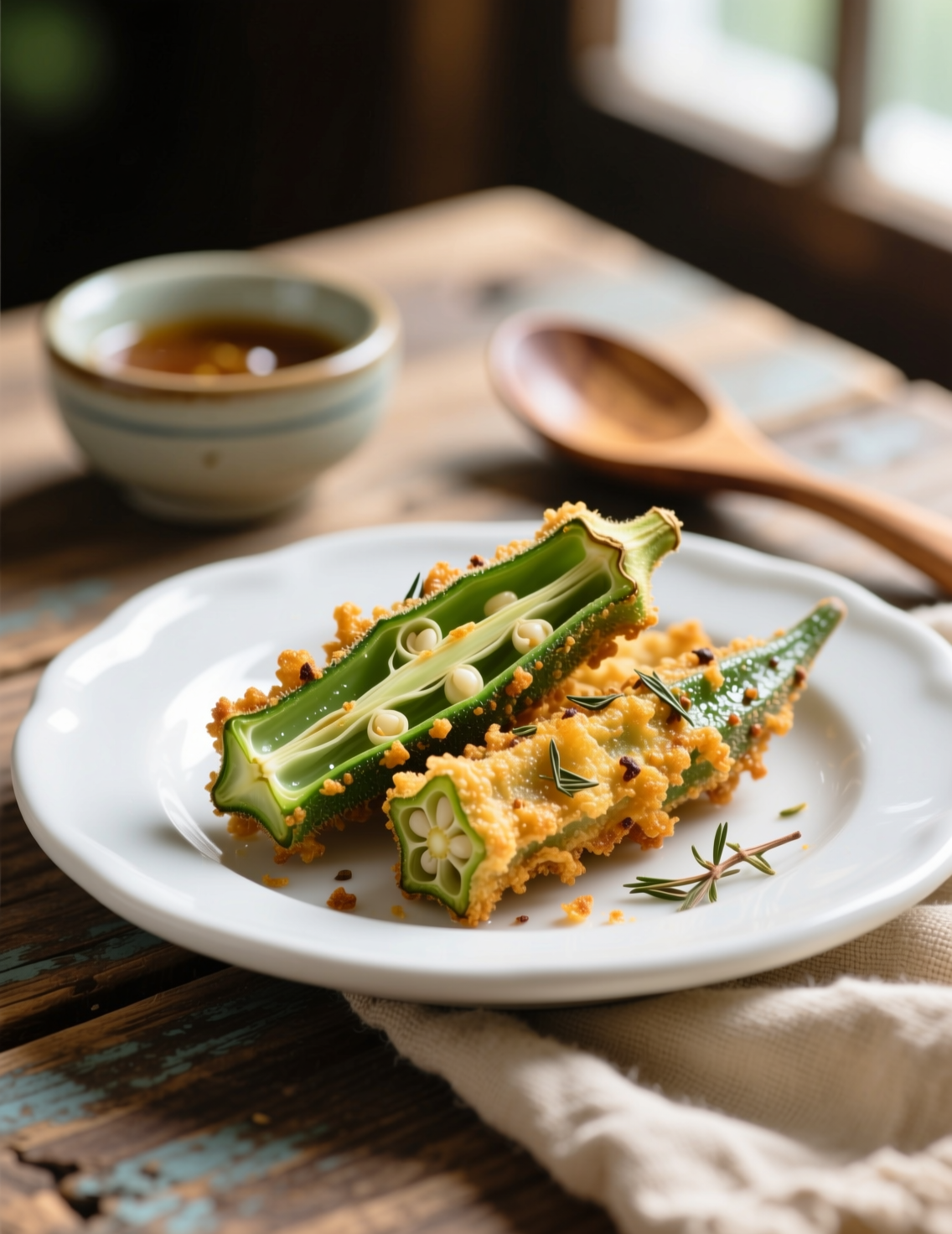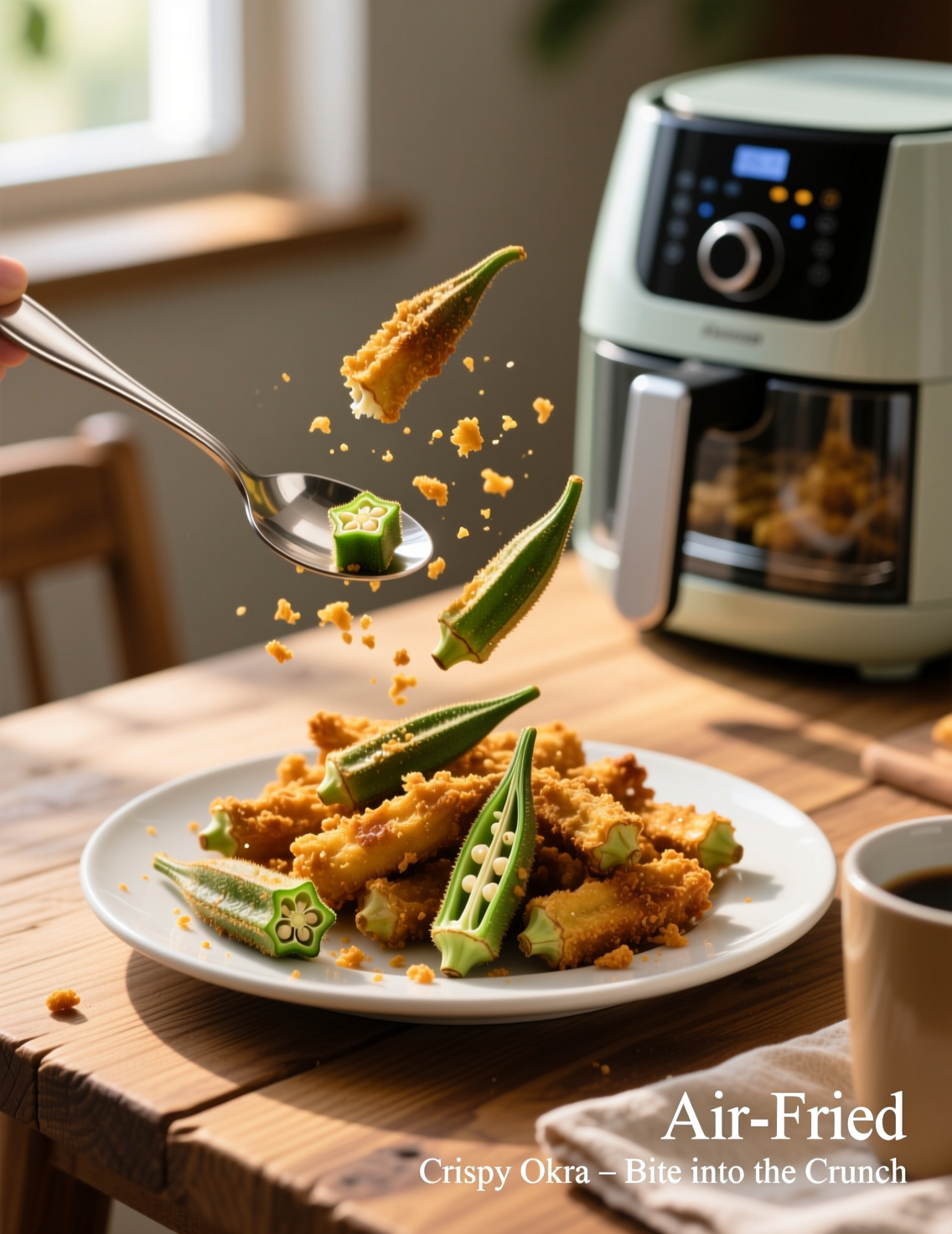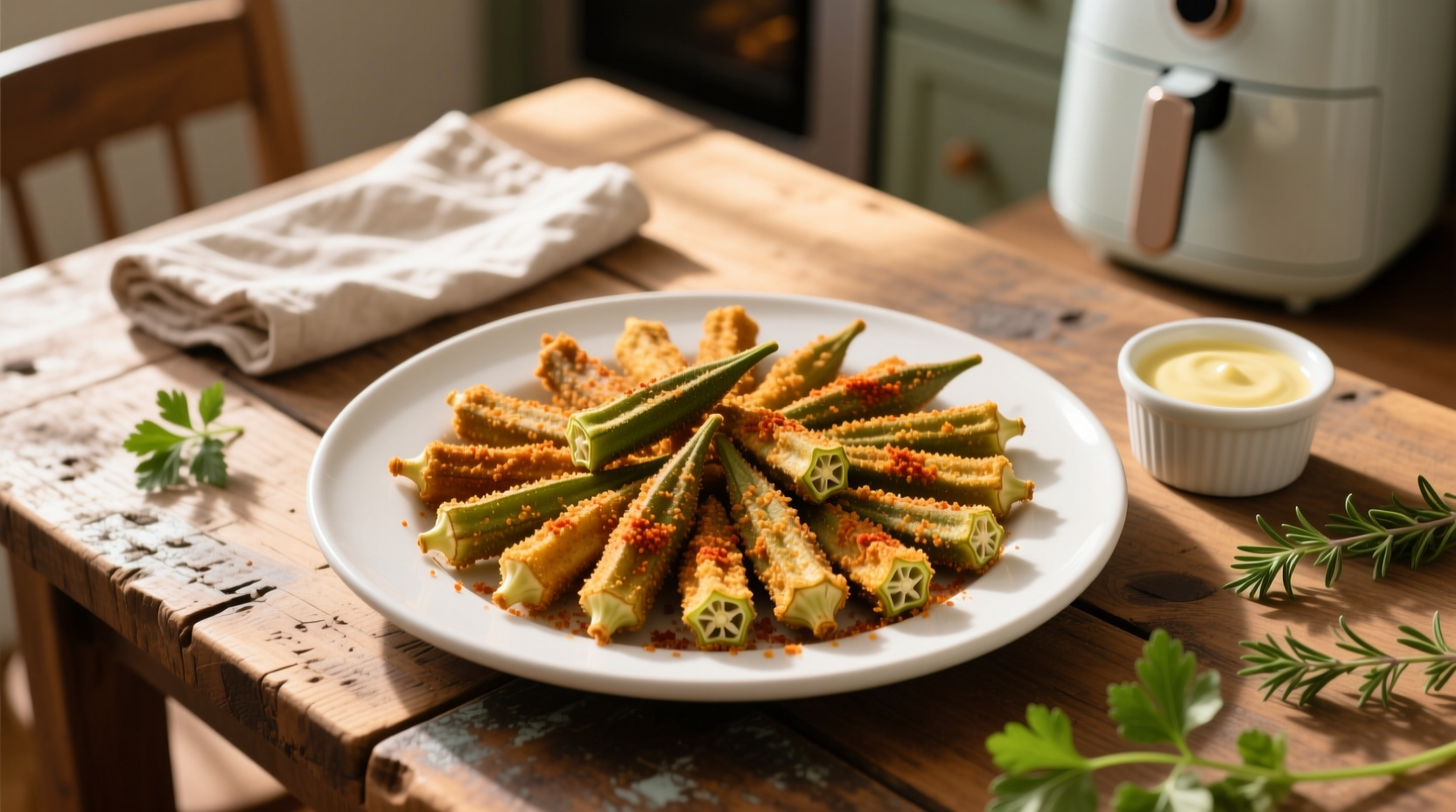Okra is one of those vegetables that tends to polarize people. Some love the silky, almost slippery texture, while others push it to the side of their plate with no hesitation. But when you learn how to make okra crispy in the air fryer, everything changes. Suddenly, what was once slimy becomes light, crunchy, and loaded with flavor. This article breaks down exactly how to achieve that level of perfection, step by step, while giving you the professional-level insights to elevate this humble vegetable.
Why Air Fryer Okra Works So Well
Okra is known for producing mucilage—the sticky substance that makes gumbo thick but also gives the vegetable its “slimy” reputation. High, dry heat is the best way to fight back against that texture. Traditionally, frying in oil solved the problem, but it left you with a greasy kitchen and more calories than you might want.
The air fryer steps in as the perfect tool. With powerful convection heat, it creates a crisp outer shell without drowning the okra in oil. You get the crunch of deep frying, but with a fraction of the fat. Studies from the Journal of Food Science have shown that air-fried vegetables retain more antioxidants than their deep-fried counterparts, which makes this technique not only delicious but also more nutritious.
And here’s something many cooks don’t realize: the shape of the okra matters. Slice it too thin, and it burns before the inside cooks. Leave it whole, and you’ll risk steamed pods with limp skins. The sweet spot? About half-inch slices. That’s where you get crisp without compromising flavor.
Ingredients You’ll Need
- 1 pound fresh okra, washed and dried
- 2 tablespoons olive oil (or avocado oil for a higher smoke point)
- ½ cup cornmeal or panko breadcrumbs
- 2 tablespoons all-purpose flour
- 1 teaspoon smoked paprika
- ½ teaspoon garlic powder
- ½ teaspoon onion powder
- ½ teaspoon cayenne pepper (optional)
- 1 teaspoon kosher salt
- ½ teaspoon black pepper
That’s the base. But here’s a chef’s secret: add a teaspoon of rice flour to the dry coating. It pulls moisture away and increases crunch, a trick often used in Japanese tempura frying. Professionals know it’s not about more breading, but about the right combination of starches.

Step 1: Prep the Okra Correctly
This is the most overlooked step. Rinse the pods thoroughly, but here’s where many go wrong—they leave them wet. Moisture is the enemy of crispness. Pat the okra dry with a clean kitchen towel or even let it sit uncovered in the fridge for an hour to air-dry.
Then slice the pods into half-inch rounds. Some chefs recommend tossing them immediately with a teaspoon of vinegar or lemon juice before breading. Why? The acidity helps break down the mucilage, reducing sliminess. A small step, yes, but it changes the final texture more than most people expect.
Step 2: Season and Coat
In one bowl, whisk together your cornmeal, flour, spices, salt, and pepper. In another, toss the sliced okra with olive oil until evenly coated. The oil acts like glue, helping the dry mix stick without the need for egg wash.
Some home cooks complain the breading doesn’t hold. The pro tip: don’t overcoat. Shake off excess before laying the slices on a tray. If you want a thicker coating, double-dip—oil, dredge, then oil again, dredge again. But remember, thicker doesn’t always mean better. Too much coating can smother the flavor of the vegetable itself.
Step 3: Arrange in the Air Fryer
This is where patience comes in. Don’t dump the okra in like it’s a basket of fries. Spread the slices in a single layer with space between each one. Crowding equals steaming, and steaming equals soggy okra.
If your air fryer is small, cook in batches. Yes, it takes longer, but professional chefs never sacrifice texture for convenience. Think of it as restaurant-level discipline. You’d never expect a fine kitchen to send out limp, overcrowded fries, right? Same logic applies here.
Step 4: Cook at the Right Temperature
Set the air fryer to 400°F (200°C). Cook for 10–12 minutes, shaking the basket halfway through. That shake matters. It exposes different surfaces to the heat, ensuring even browning.
Here’s where expertise makes the difference: listen for the sound. Okra should rattle crisply when shaken, not stick together in a damp clump. If it sounds soft, cook another 2–3 minutes. Every air fryer behaves a bit differently depending on airflow and wattage, so trust your senses more than the clock.
Step 5: Season and Serve Immediately
The moment the okra comes out, dust it with a pinch of finishing salt. Salt sticks better to hot surfaces, not cool ones. Serve immediately, because air fryer crispness is fleeting. Within 15 minutes, condensation can soften the coating.
For a flavor boost, try sprinkling with a squeeze of lime or tossing with grated Parmesan. In the South, some folks even serve it with a side of remoulade or spicy ranch. I’ve seen chefs drizzle it lightly with hot honey for a sweet-spicy twist that disappears in seconds at the table.
Nutritional Benefits
Air frying cuts fat by as much as 70–80% compared to deep frying, according to USDA data. Okra itself is rich in vitamins A, C, and K, plus folate and magnesium. The fiber content is particularly high, which makes it a filling side dish with very few calories.
This means you can serve crispy okra not just as a snack but as part of a balanced meal. Imagine pairing it with grilled salmon and a quinoa salad. You get texture contrast, nutrition, and flavor harmony all in one plate.
Common Mistakes to Avoid
One mistake I see often is slicing the okra too thin. Thin slices dry out and burn before the coating crisps. Another is soaking the okra in egg wash without drying it first—this leads to clumpy, uneven coating.
And please, don’t overcrowd. If you stack slices on top of each other, you’re essentially steaming them. That defeats the entire purpose of the air fryer. Always leave breathing room, even if it means cooking in multiple rounds.

Variations for Professionals
The classic Southern version uses cornmeal, but there’s room for experimentation. Try a tempura-style batter made with rice flour and sparkling water for a lighter crunch. Or swap in chickpea flour for a nuttier flavor that’s gluten-free.
Spice blends also change the game. A Cajun mix brings heat, while curry powder gives it an Indian twist. In one restaurant I consulted for, we tossed air-fried okra with za’atar and a drizzle of tahini for a Middle Eastern spin. Guests couldn’t stop ordering it.
Serving Ideas Beyond a Side Dish
Okra doesn’t need to stay in the “side dish” category. Air-fried okra makes a fantastic topping for grain bowls, adding crunch to soft elements like roasted sweet potatoes or lentils. It also works beautifully in tacos—yes, tacos. Replace the fried fish with crispy okra and pair it with slaw and chipotle mayo.
Another idea: garnish soups with crispy okra. Instead of croutons, scatter a handful over a bowl of creamy tomato or butternut squash soup. The crunch contrasts with the smoothness in a way that feels both rustic and refined.
Addressing the Sliminess Question
People always ask: will air frying completely eliminate slime? The answer is yes and no. Proper drying and high heat remove most of it, but a tiny bit may linger inside thicker slices. That’s not a flaw—it’s the vegetable’s natural characteristic.
Think of it like eating oysters. Some folks embrace the texture; others need it dressed up. Air frying reduces the trait enough that even skeptics often become fans. If someone claims they “hate okra,” serve them this version and watch their expression change after the first bite.
Emerging Trends with Air Fryer Vegetables
The rise of air fryers has shifted how chefs think about vegetable sides. Once overlooked veggies like okra, Brussels sprouts, and radishes are making comebacks in modern kitchens. Restaurants are even offering “air-fried small plates” as healthier alternatives to bar snacks.
Market research from Statista shows that air fryer sales have skyrocketed, with over 40% of U.S. households owning one by 2023. That means professional kitchens adapting these techniques are not just following a fad—they’re meeting a growing demand.
Final Thoughts
Crispy air fryer okra isn’t just a trick for home cooks. It’s a professional-level dish when treated with respect. Dry the pods properly, coat them thoughtfully, cook in disciplined batches, and season right out of the fryer. Do those things, and you’ll transform a divisive vegetable into a crowd-pleasing star.
The next time someone pushes okra aside, offer them a plate of these golden-brown bites. No slime, no grease, just pure crunch. Sometimes the simplest vegetables, cooked with the sharpest technique, leave the most lasting impression.
FAQs
Can I make air fryer okra without breading?
Yes, just season with oil, salt, and spices for a lighter, crisp texture.
Why does my air fryer okra turn out soggy?
It’s usually from overcrowding the basket or not drying the okra properly.
How long should I cook okra in the air fryer?
About 10–12 minutes at 400°F, shaking halfway for even crispness.
Do I need to preheat the air fryer?
Yes, preheating ensures faster cooking and crispier results.
Can frozen okra be used in this recipe?
Yes, but thaw and pat dry first to avoid excess moisture.
What’s the best coating for extra crunch?
A mix of cornmeal and rice flour creates a crisp, golden finish.
How do I store leftover air-fried okra?
Keep in an airtight container and reheat in the air fryer for best texture.
Will air frying completely remove the sliminess?
Mostly yes, though a little natural texture may remain inside thicker slices.
What dipping sauces go well with air fryer okra?
Spicy ranch, remoulade, or even hot honey pair perfectly.
Can air fryer okra be made gluten-free?
Yes, just replace flour with chickpea or rice flour for a gluten-free coating.

Mariana is a passionate home cook who creates delicious, easy-to-follow recipes for busy people. From energizing breakfasts to satisfying dinners and indulgent desserts, her dishes are designed to fuel both your body and hustle.
When she’s not in the kitchen, she’s exploring new flavors and dreaming up her next recipe to share with the Foodie Hustle community.

